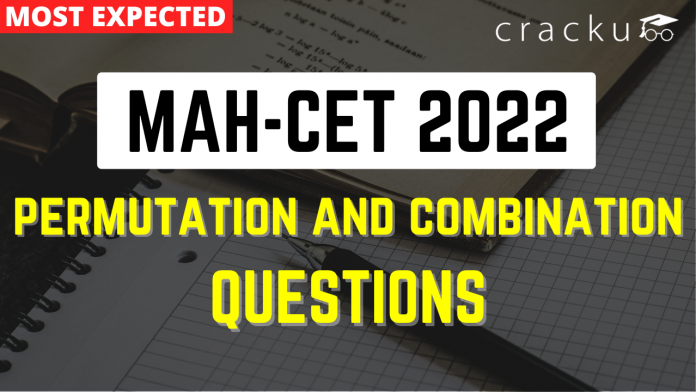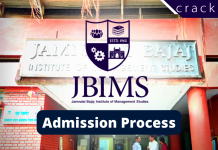Permutation and Combination Questions for MAH-CET
Here you can download a free Permutation and Combination questions PDF with answers for MAH MBA CET 2022 by Cracku. These are some tricky questions in the MAH MBA CET 2022 exam that you need to find the Permutation and Combination of answers for the given questions. These questions will help you to make practice and solve the Permutation and Combination questions in the MAH MBA CET exam. Utilize this best PDF practice set which is included answers in detail. Click on the below link to download the Permutation and Combination MCQ PDF for MBA-CET 2022 for free.
Download Permutation and Combination Questions for MAH-CET
Enroll to MAH-CET 2022 Crash Course
Instructions
From the following, differen committees are to be made as per the requirement given in each question.
In how many different ways can it de done? 10 men and 8 women out of which 5 men are teachers, 3 men doctors and businessmen. Among the women, 3 are 2 are teachers, 2 doctors, 2 researchers and 1 social worker.
Question 1: A Committee of 3 in which there is no teacher and no doctor.
a) 100
b) 120
c) 10
d) 12
e) None of these
1) Answer (C)
Solution:
Out of 10 men, Teachers = 5
Doctors = 3 and Business man = 2
Out of 8 women, Teachers = 3 and Doctors = 2
Researchers = 2 and Social worker = 1
Now, no teacher and doctor should be selected.
=> Remaining members (both men and women) = (2) + (2 + 1) = 5
Thus, number of ways of selecting 3 people out of 5
= $C^5_3 = \frac{5 \times 4 \times 3}{1 \times 2 \times 3} = 10$
Question 2: A Committee of 7.
a) 31824
b) 1200
c) 9600
d) 15912
e) None of these
2) Answer (A)
Solution:
There are 10 men and 8 women, Total = 18
Number of ways of selecting 7 members out of 18.
= $C^{18}_7 = \frac{18 \times 17 \times 16 \times 15 \times 14 \times 13 \times 12}{1 \times 2 \times 3 \times 4 \times 5 \times 6 \times 7}$
= $18 \times 17 \times 4 \times 13 \times 2 = 31824$
Question 3: A Committee is 5 in which 2 men teachers, 2 women teachers and 1 doctor are there.
a) 75
b) 150
c) 214
d) 20
e) None of these
3) Answer (B)
Solution:
Out of 10 men, Teachers = 5
Doctors = 3 and Business man = 2
Out of 8 women, Teachers = 3 and Doctors = 2
Researchers = 2 and Social worker = 1
Number of ways of selecting 2 men teachers, 2 women teachers and 1 doctor
= $C^5_2 \times C^3_2 \times C^5_1$
= $\frac{5 \times 4}{1 \times 2} \times \frac{3 \times 2}{1 \times 2} \times \frac{5}{1}$
= $10 \times 3 \times 5 = 150$
Question 4: A Committee of 4 in which at least 2 women are there.
a) 1260
b) 1820
c) 3060
d) 1890
e) None of these
4) Answer (D)
Solution:
Out of 10 men, Teachers = 5
Doctors = 3 and Business man = 2
Out of 8 women, Teachers = 3 and Doctors = 2
Researchers = 2 and Social worker = 1
Number of ways of selecting 4 members in which at least 2 are women
= (2 men , 2 women) + (1 men , 3 women) + (0 men , 4 women)
= $(C^{10}_2 \times C^8_2) + (C^{10}_1 \times C^8_3) + (C^{10}_0 \times C^8_4)$
= $(\frac{10 \times 9}{1 \times 2} \times \frac{8 \times 7}{1 \times 2}) + (\frac{10}{1} \times \frac{8 \times 7 \times 6}{1 \times 2 \times 3}) + (\frac{8 \times 7 \times 6 \times 5}{1 \times 2 \times 3 \times 4})$
= $(45 \times 28) + (10 \times 56) + (70)$
= $1260 + 560 + 70 = 1890$
Question 5: A Committee of 5 in which 3 men and 2 women are there.
a) 3360
b) 8568
c) 4284
d) 1680
e) None of these
5) Answer (A)
Solution:
Out of 10 men, Teachers = 5
Doctors = 3 and Business man = 2
Out of 8 women, Teachers = 3 and Doctors = 2
Researchers = 2 and Social worker = 1
Number of ways of selecting 3 men and 2 women.
= $C^{10}_3 \times C^8_2$
= $\frac{10 \times 9 \times 8}{1 \times 2 \times 3} \times \frac{8 \times 7}{1 \times 2}$
= $120 \times 28 = 3360$
Take Free MAH-CET mock tests here
Enroll to 5 MAH CET Latest Mocks For Just Rs. 299
Instructions
Study the given information carefully and answer the questions that follow:
An urn contains 3 red, 6 blue, 2 green and 4 yellow marbles.
Question 6: If four marbles are picked at random, what is the probability that one is green, two are blue and one is red ?
a) 4/15
b) 17/280
c) 6/91
d) 11/15
e) None of these
6) Answer (C)
Solution:
Total number of marbles in the urn = 15
P(S) = Total possible outcomes
= Selecting 4 marbles at random out of 15
=> $P(S) = C^{15}_4 = \frac{15 \times 14 \times 13 \times 12}{1 \times 2 \times 3 \times 4}$
= $1365$
P(E) = Favorable outcomes
= Selecting 1 green, 2 blue and 1 red marble.
=> $P(E) = C^2_1 \times C^6_2 \times C^3_1$
= $2 \times \frac{6 \times 5}{1 \times 2} \times 3$
= $90$
$\therefore$ Required probability = $\frac{P(E)}{P(S)}$
= $\frac{90}{1365} = \frac{6}{91}$
Question 7: If two marbles are picked at random, what is the probability that either both are red or both are green ?
a) 3/5
b) 4/105
c) 2/7
d) 5/91
e) None of these
7) Answer (B)
Solution:
Total number of marbles in the urn = 15
P(S) = Total possible outcomes
= Selecting 2 marbles at random out of 15
=> $P(S) = C^{15}_2 = \frac{15 \times 14}{1 \times 2}$
= $105$
P(E) = Favorable outcomes
= Selecting 2 green or 2 red marbles.
=> $P(E) = C^2_2 + C^3_2$
= $1 + \frac{3 \times 2}{1 \times 2}$
= $4$
$\therefore$ Required probability = $\frac{P(E)}{P(S)}$
= $\frac{4}{105}$
Question 8: If four marbles are picked at random, what is the probability that at least one is yellow ?
a) 91/123
b) 69/91
c) 125/143
d) 1/3
e) None of these
8) Answer (B)
Solution:
Total number of marbles in the urn = 15
P(S) = Total possible outcomes
= Selecting 4 marbles at random out of 15
=> $P(S) = ^{15}C_4 = \frac{15 \times 14 \times 13 \times 12}{1 \times 2 \times 3 \times 4}$
= $1365$
Let no yellow marble is selected.
P(E) = Favorable outcomes
= Selecting 4 out of 11 marbles.
=> $P(E) = ^{11}C_4$
= $\frac{11 \times 10 \times 9 \times 8}{1 \times 2 \times 3 \times 4}$
= $330$
$\therefore$ Required probability = $1 – \frac{P(E)}{P(S)}$
= $1 – \frac{330}{1365} = 1 – \frac{22}{91}$
= $\frac{91 – 22}{91} = \frac{69}{91}$
Question 9: If three marbles are picked at random, what is the probability that two are blue and one is yellow ?
a) 2/15
b) 6/91
c) 12/91
d) 3/15
e) None of these
9) Answer (C)
Solution:
Total number of marbles in the urn = 15
P(S) = Total possible outcomes
= Selecting 3 marbles at random out of 15
=> $P(S) = ^{15} C_3 = \frac{15 \times 14 \times 13}{1 \times 2 \times 3}$
= $455$
P(E) = Favorable outcomes
= Selecting 2 blue and 1 yellow marble.
=> $P(E) =C^6_2 \times C^4_1$
= $\frac{6 \times 5}{1 \times 2} \times 4$
= $60$
$\therefore$ Required probability = $\frac{P(E)}{P(S)}$
= $\frac{60}{455} = \frac{12}{91}$
Question 10: If two marbles are picked at random, what is the probability that both are green ?
a) 2/15
b) 1/15
c) 2/7
d) 1
e) None of these
10) Answer (E)
Solution:
Total number of marbles in the urn = 15
P(S) = Total possible outcomes
= Selecting 2 marbles at random out of 15
=> $P(S) = C^{15}_2 = \frac{15 \times 14}{1 \times 2}$
= $105$
P(E) = Favorable outcomes
= Selecting 2 green marbles.
=> $P(E) = C^2_2 = 1$
$\therefore$ Required probability = $\frac{P(E)}{P(S)}$
= $\frac{1}{105}$
Instructions
Study the given information carefully and answer the questions that follow:
An urn contains 6 red, 4 blue, 2 green, 3 yellow marbles.
Question 11: If two marbles are picked at random what is the probability that either both are green or both are yellow ?
a) $\frac{5}{91}$
b) $\frac{1}{35}$
c) $\frac{1}{3}$
d) $\frac{4}{105}$
e) None of these
11) Answer (D)
Solution:
Number of ways of selecting 2 green marbles or 2 yellow marbles = $^2C_2+^3C_2$ = 1+3 = 4
Probability = $4/^{15}C_2$ = 4/155
Question 12: If four marbles are picked at random what is the probability that one is green two are blue and one is red ?
a) $\frac{24}{455}$
b) $\frac{13}{35}$
c) $\frac{11}{15}$
d) $\frac{7}{91}$
e) None of these
12) Answer (A)
Solution:
One green marble can be selected in $^2C_1$ = 2 ways.
Two blue marbles can be selected in $^4C_2 = 6$ ways
Six red marbles can be selected in $^6C_1 = 6$ ways.
Probability = $\frac{2*6*6}{^{15}C_4}$ = 24/455
Question 13: If three marbles are picked at random what is the probability that two are blue and one is yellow ?
a) $\frac{3}{91}$
b) $\frac{1}{5}$
c) $\frac{18}{455}$
d) $\frac{7}{15}$
e) None of these
13) Answer (C)
Solution:
Total number of ways to pick up 3 marbles = $^{15}C_3$ = 455
Total number of favourable events = $^4C_2*3$ = 18
Hence, probability = $\frac{18}{455}$
Question 14: If two marbles are picked at random what is the probability that both are red ?
a) $\frac{1}{6}$
b) $\frac{1}{3}$
c) $\frac{2}{15}$
d) $\frac{2}{5}$
e) None of these
14) Answer (E)
Solution:
Required probability would be $^6C_2/^{15}C_2$ = 1/7 as we are selecting 2 balls out of 6 red balls out og the total possibility set of 2 balls out of 15 balls.
Question 15: If four marbles are picked at random what is the probability that at least one is blue ?
a) $\frac{4}{15}$
b) $\frac{69}{91}$
c) $\frac{11}{15}$
d) $\frac{22}{91}$
e) None of these
15) Answer (B)
Solution:
Total number of events = $^{15}C_4$ = 1365
Probability of at least 1 Blue = 1 – (Probability of 0 blue)
Probability of 0 blue = $\frac{^{11}C_4}{1365}$ = $\frac{22}{91}$
Probability of at least 1 Blue = 1 – $\frac{22}{91}$ = $\frac{69}{91}$





